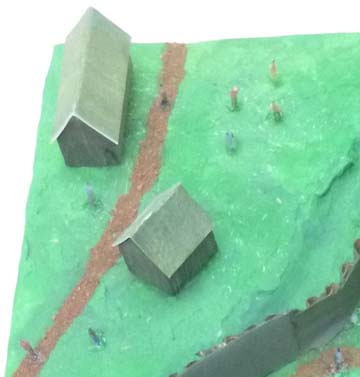The village outside the castle
Life was hard for a medieval peasant and the work was backbreaking. It followed the seasons; ploughing in autumn, sowing in spring, harvesting in August. Work began at dawn, preparing the animals, and it finished at dusk, cleaning them down and putting them back into the stalls.
A peasant's hut was made of wattle and daub, with a thatch roof but no windows. Inside the hut, a third of the area was penned off for the animals, which lived in the hut with the family. A fire burned in a hearth in the centre of the hut, so the air was permanently smoky. Furniture was maybe a couple of stools, bedding, and a few cooking pots.
Peasant food was mainly vegetables, plus anything that they could find such as; nuts, berries, nettles. The usual drink was weak, home-brewed beer. Honey provided a sweetener. The only bread a peasant could afford was black rye bread. The most difficult time was late spring, when food stores were running out, and new food was not yet growing. A poor harvest meant that some of the villagers would starve to death.
A male peasant would wear a rough tunic, with a hood and gloves, and leather shoes with wooden soles. Women wore a coarse gown over a sleeveless slip.
Village life was not all misery. Holy days meant a day off work. Peasant fun was wrestling, shin kicking and cock-fighting. The ball was almost unnecessary to a medieval ball game, which was basically a fight with the next village.

model of a Norman motte and bailey castle